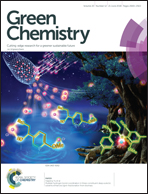Continuous pervaporation-assisted furfural production catalyzed by CrCl3†
Abstract
Furfural—a precursor to fuels, solvents, and polymers—is produced by acid-catalyzed dehydration of biomass-derived xylose; however, the selectivity of this process is limited by side reactions which form low-value byproducts known as humins. The production of humins can be reduced by extracting furfural as it is produced. In this paper we report the design and performance of a membrane-pervaporation-assisted reactor for the continuous CrCl3-catalyzed conversion of xylose to furfural. Pervaporation offers a simple means for separating products from homogeneous catalysts and reactants with negligible vapor pressure. By combining reaction with product pervaporation, it was possible to produce furfural continuously without catalyst addition during the reaction. We also conducted simulations of the continuous reaction while varying the membrane-area-to-reactor-volume ratio, av. These simulations showed that there is an optimal value of av for which the permeate concentration of furfural and reaction selectivity are maximized. For the parameters used in this study, the optimal value of av is 0.17 cm−1. Our work provides a basis for the design of a continuous pervaporation-assisted reactor and illustrates the sensitivity of this approach to individual system parameters.



 Please wait while we load your content...
Please wait while we load your content...